Circadian rhythm disruptions associated with opioid use disorder in synaptic proteomes of human dorsolateral prefrontal cortex and nucleus accumbens
- PMID: 37674018
- PMCID: PMC10914630
- DOI: 10.1038/s41380-023-02241-6
Circadian rhythm disruptions associated with opioid use disorder in synaptic proteomes of human dorsolateral prefrontal cortex and nucleus accumbens
Abstract
Opioid craving and relapse vulnerability is associated with severe and persistent sleep and circadian rhythm disruptions. Understanding the neurobiological underpinnings of circadian rhythms and opioid use disorder (OUD) may prove valuable for developing new treatments for opioid addiction. Previous work indicated molecular rhythm disruptions in the human brain associated with OUD, highlighting synaptic alterations in the dorsolateral prefrontal cortex (DLPFC) and nucleus accumbens (NAc)-key brain regions involved in cognition and reward, and heavily implicated in the pathophysiology of OUD. To provide further insights into the synaptic alterations in OUD, we used mass-spectrometry based proteomics to deeply profile protein expression alterations in bulk tissue and synaptosome preparations from DLPFC and NAc of unaffected and OUD subjects. We identified 55 differentially expressed (DE) proteins in DLPFC homogenates, and 44 DE proteins in NAc homogenates, between unaffected and OUD subjects. In synaptosomes, we identified 161 and 56 DE proteins in DLPFC and NAc, respectively, of OUD subjects. By comparing homogenate and synaptosome protein expression, we identified proteins enriched specifically in synapses that were significantly altered in both DLPFC and NAc of OUD subjects. Across brain regions, synaptic protein alterations in OUD subjects were primarily identified in glutamate, GABA, and circadian rhythm signaling. Using time-of-death (TOD) analyses, where the TOD of each subject is used as a time-point across a 24-h cycle, we were able to map circadian-related changes associated with OUD in synaptic proteomes associated with vesicle-mediated transport and membrane trafficking in the NAc and platelet-derived growth factor receptor beta signaling in DLPFC. Collectively, our findings lend further support for molecular rhythm disruptions in synaptic signaling in the human brain as a key factor in opioid addiction.
© 2023. The Author(s).
Conflict of interest statement
The authors report no competing interests.
Figures
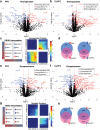
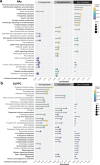

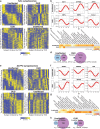
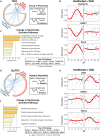
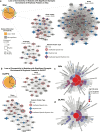
Update of
-
Circadian rhythm disruptions associated with opioid use disorder in the synaptic proteomes of the human dorsolateral prefrontal cortex and nucleus accumbens.bioRxiv [Preprint]. 2023 Aug 24:2023.04.07.536056. doi: 10.1101/2023.04.07.536056. bioRxiv. 2023. Update in: Mol Psychiatry. 2023 Nov;28(11):4777-4792. doi: 10.1038/s41380-023-02241-6. PMID: 37066169 Free PMC article. Updated. Preprint.
Similar articles
-
Circadian rhythm disruptions associated with opioid use disorder in the synaptic proteomes of the human dorsolateral prefrontal cortex and nucleus accumbens.bioRxiv [Preprint]. 2023 Aug 24:2023.04.07.536056. doi: 10.1101/2023.04.07.536056. bioRxiv. 2023. Update in: Mol Psychiatry. 2023 Nov;28(11):4777-4792. doi: 10.1038/s41380-023-02241-6. PMID: 37066169 Free PMC article. Updated. Preprint.
-
Molecular rhythm alterations in prefrontal cortex and nucleus accumbens associated with opioid use disorder.Transl Psychiatry. 2022 Mar 26;12(1):123. doi: 10.1038/s41398-022-01894-1. Transl Psychiatry. 2022. PMID: 35347109 Free PMC article.
-
Transcriptional Alterations in Dorsolateral Prefrontal Cortex and Nucleus Accumbens Implicate Neuroinflammation and Synaptic Remodeling in Opioid Use Disorder.Biol Psychiatry. 2021 Oct 15;90(8):550-562. doi: 10.1016/j.biopsych.2021.06.007. Epub 2021 Jun 12. Biol Psychiatry. 2021. PMID: 34380600 Free PMC article.
-
Looking beyond the opioid receptor: A desperate need for new treatments for opioid use disorder.J Neurol Sci. 2022 Jan 15;432:120094. doi: 10.1016/j.jns.2021.120094. Epub 2021 Dec 16. J Neurol Sci. 2022. PMID: 34933249 Review.
-
Neurological correlates of brain reward circuitry linked to opioid use disorder (OUD): Do homo sapiens acquire or have a reward deficiency syndrome?J Neurol Sci. 2020 Nov 15;418:117137. doi: 10.1016/j.jns.2020.117137. Epub 2020 Sep 15. J Neurol Sci. 2020. PMID: 32957037 Free PMC article. Review.
Cited by
-
Disrupted Circadian Rhythms and Substance Use Disorders: A Narrative Review.Clocks Sleep. 2024 Aug 19;6(3):446-467. doi: 10.3390/clockssleep6030030. Clocks Sleep. 2024. PMID: 39189197 Free PMC article. Review.
-
Proteomic insights into the biology of dopaminergic neurons.Front Mol Neurosci. 2025 Jul 30;18:1642519. doi: 10.3389/fnmol.2025.1642519. eCollection 2025. Front Mol Neurosci. 2025. PMID: 40808910 Free PMC article. Review.
-
Chloride/proton antiporters ClC3 and ClC5 support bone formation in mice.Bone Rep. 2024 Apr 16;21:101763. doi: 10.1016/j.bonr.2024.101763. eCollection 2024 Jun. Bone Rep. 2024. PMID: 38666049 Free PMC article.
-
Spectral divergence prioritizes key classes, genes, and pathways shared between substance use disorders and cardiovascular disease.Front Neurosci. 2025 Jul 22;19:1572243. doi: 10.3389/fnins.2025.1572243. eCollection 2025. Front Neurosci. 2025. PMID: 40766907 Free PMC article.
-
Rest-Activity Rhythms, Their Modulators, and Brain-Clinical Correlates in Opioid Use Disorder.JAMA Netw Open. 2025 Feb 3;8(2):e2457976. doi: 10.1001/jamanetworkopen.2024.57976. JAMA Netw Open. 2025. PMID: 39903462 Free PMC article.
References
-
- National Institute on Drug Abuse. Drug overdose death rates. National Institute on Drug Abuse; 2023. https://nida.nih.gov/research-topics/trends-statistics/overdose-death-rates. Accessed 23 March 2023.
MeSH terms
Substances
Grants and funding
LinkOut - more resources
Full Text Sources
Medical

